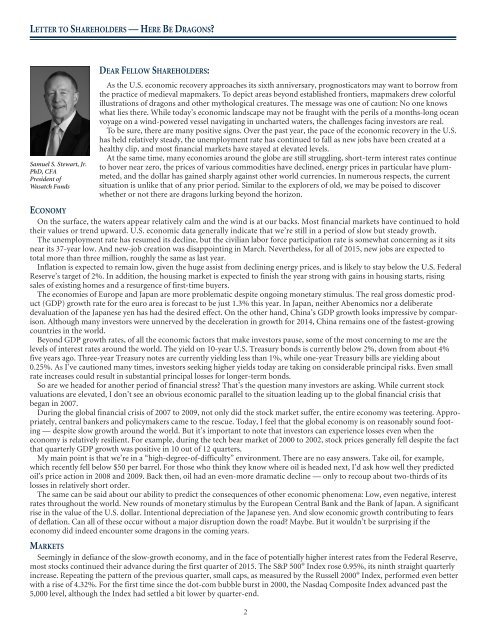WASATCH FUNDS - Curian Clearing
WASATCH FUNDS - Curian Clearing
WASATCH FUNDS - Curian Clearing
You also want an ePaper? Increase the reach of your titles
YUMPU automatically turns print PDFs into web optimized ePapers that Google loves.
LETTER TO SHAREHOLDERS —HERE BE DRAGONS?<br />
Samuel S. Stewart, Jr.<br />
PhD, CFA<br />
President of<br />
Wasatch Funds<br />
DEAR FELLOW SHAREHOLDERS:<br />
As the U.S. economic recovery approaches its sixth anniversary, prognosticators may want to borrow from<br />
the practice of medieval mapmakers. To depict areas beyond established frontiers, mapmakers drew colorful<br />
illustrations of dragons and other mythological creatures. The message was one of caution: No one knows<br />
what lies there. While today’s economic landscape may not be fraught with the perils of a months-long ocean<br />
voyage on a wind-powered vessel navigating in uncharted waters, the challenges facing investors are real.<br />
To be sure, there are many positive signs. Over the past year, the pace of the economic recovery in the U.S.<br />
has held relatively steady, the unemployment rate has continued to fall as new jobs have been created at a<br />
healthy clip, and most financial markets have stayed at elevated levels.<br />
At the same time, many economies around the globe are still struggling, short-term interest rates continue<br />
to hover near zero, the prices of various commodities have declined, energy prices in particular have plummeted,<br />
and the dollar has gained sharply against other world currencies. In numerous respects, the current<br />
situation is unlike that of any prior period. Similar to the explorers of old, we may be poised to discover<br />
whether or not there are dragons lurking beyond the horizon.<br />
ECONOMY<br />
On the surface, the waters appear relatively calm and the wind is at our backs. Most financial markets have continued to hold<br />
their values or trend upward. U.S. economic data generally indicate that we’re still in a period of slow but steady growth.<br />
The unemployment rate has resumed its decline, but the civilian labor force participation rate is somewhat concerning as it sits<br />
near its 37-year low. And new-job creation was disappointing in March. Nevertheless, for all of 2015, new jobs are expected to<br />
total more than three million, roughly the same as last year.<br />
Inflation is expected to remain low, given the huge assist from declining energy prices, and is likely to stay below the U.S. Federal<br />
Reserve’s target of 2%. In addition, the housing market is expected to finish the year strong with gains in housing starts, rising<br />
sales of existing homes and a resurgence of first-time buyers.<br />
The economies of Europe and Japan are more problematic despite ongoing monetary stimulus. The real gross domestic product<br />
(GDP) growth rate for the euro area is forecast to be just 1.3% this year. In Japan, neither Abenomics nor a deliberate<br />
devaluation of the Japanese yen has had the desired effect. On the other hand, China’s GDP growth looks impressive by comparison.<br />
Although many investors were unnerved by the deceleration in growth for 2014, China remains one of the fastest-growing<br />
countries in the world.<br />
Beyond GDP growth rates, of all the economic factors that make investors pause, some of the most concerning to me are the<br />
levels of interest rates around the world. The yield on 10-year U.S. Treasury bonds is currently below 2%, down from about 4%<br />
five years ago. Three-year Treasury notes are currently yielding less than 1%, while one-year Treasury bills are yielding about<br />
0.25%. As I’ve cautioned many times, investors seeking higher yields today are taking on considerable principal risks. Even small<br />
rate increases could result in substantial principal losses for longer-term bonds.<br />
So are we headed for another period of financial stress? That’s the question many investors are asking. While current stock<br />
valuations are elevated, I don’t see an obvious economic parallel to the situation leading up to the global financial crisis that<br />
began in 2007.<br />
During the global financial crisis of 2007 to 2009, not only did the stock market suffer, the entire economy was teetering. Appropriately,<br />
central bankers and policymakers came to the rescue. Today, I feel that the global economy is on reasonably sound footing<br />
— despite slow growth around the world. But it’s important to note that investors can experience losses even when the<br />
economy is relatively resilient. For example, during the tech bear market of 2000 to 2002, stock prices generally fell despite the fact<br />
that quarterly GDP growth was positive in 10 out of 12 quarters.<br />
My main point is that we’re in a “high-degree-of-difficulty” environment. There are no easy answers. Take oil, for example,<br />
which recently fell below $50 per barrel. For those who think they know where oil is headed next, I’d ask how well they predicted<br />
oil’s price action in 2008 and 2009. Back then, oil had an even-more dramatic decline — only to recoup about two-thirds of its<br />
losses in relatively short order.<br />
The same can be said about our ability to predict the consequences of other economic phenomena: Low, even negative, interest<br />
rates throughout the world. New rounds of monetary stimulus by the European Central Bank and the Bank of Japan. A significant<br />
rise in the value of the U.S. dollar. Intentional depreciation of the Japanese yen. And slow economic growth contributing to fears<br />
of deflation. Can all of these occur without a major disruption down the road? Maybe. But it wouldn’t be surprising if the<br />
economy did indeed encounter some dragons in the coming years.<br />
MARKETS<br />
Seemingly in defiance of the slow-growth economy, and in the face of potentially higher interest rates from the Federal Reserve,<br />
most stocks continued their advance during the first quarter of 2015. The S&P 500 ® Index rose 0.95%, its ninth straight quarterly<br />
increase. Repeating the pattern of the previous quarter, small caps, as measured by the Russell 2000 ® Index, performed even better<br />
with a rise of 4.32%. For the first time since the dot-com bubble burst in 2000, the Nasdaq Composite Index advanced past the<br />
5,000 level, although the Index had settled a bit lower by quarter-end.<br />
2




